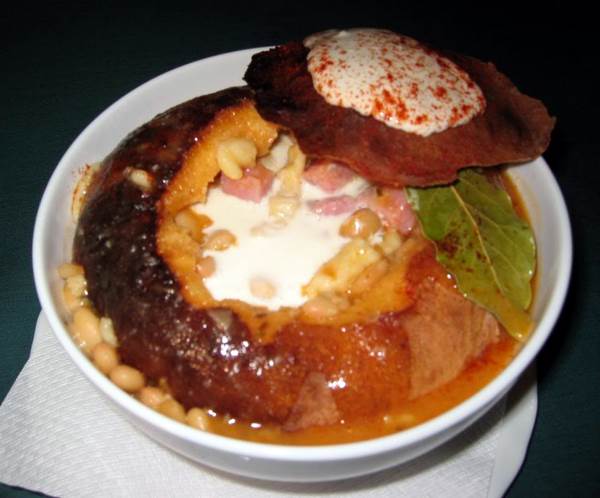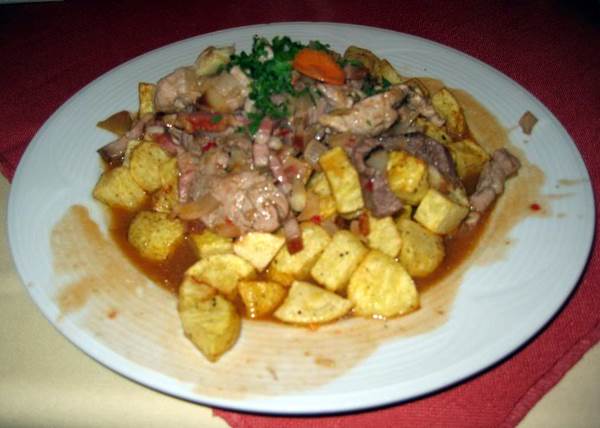Hungary has a rich culinary tradition – and not just in the sense of being the result of many intertwining cultural influences. Hungarians make filling and flavorful food, heavy on meat – especially pork – and featuring plentiful spices, garlic, cream, and fruit.
 The best-known Hungarian dish is goulash, a substantial stew in which chunks of beef, onion and potato swim in a thick, paprika-laced broth. An alternative version of this is a bean goulash, though this is not generally a vegetarian dish – the beans are often complemented by chunks of bacon. Jokai bean soup is another delicious dish of beans with chunks of pork. French onion soup has been adopted as a staple of local cuisine, and the similar – but tangier – garlic cream soup is also popular. Hungarian soups and goulashes often go well with a dollop of sour cream, and can be particularly delicious when served inside a hollowed-out bread loaf.
The best-known Hungarian dish is goulash, a substantial stew in which chunks of beef, onion and potato swim in a thick, paprika-laced broth. An alternative version of this is a bean goulash, though this is not generally a vegetarian dish – the beans are often complemented by chunks of bacon. Jokai bean soup is another delicious dish of beans with chunks of pork. French onion soup has been adopted as a staple of local cuisine, and the similar – but tangier – garlic cream soup is also popular. Hungarian soups and goulashes often go well with a dollop of sour cream, and can be particularly delicious when served inside a hollowed-out bread loaf.
As for main courses, one of the classics is paprikas csirke (paprika chicken), in which chunks of  poultry are slow cooked in a sauce containing sour cream, tomato and paprika. It is traditionally served with small dumplings. The sinful ciganypecsenye (gypsy roast) consists of a garlic-soaked slab of meat, often served with a curl of fried fat on top. Wiener schnitzel – a big disk of veal or pork, breaded and fried – is an Austrian dish that has become popular in Hungary. And then there is brassoi apropecsenye, a dish originating from the Hungarian-speaking population of Transylvania and consisting of small chunks of pork, chicken, beef, bacon, red pepper, tomato and potatoes, all fried up – again, with lots of garlic.
poultry are slow cooked in a sauce containing sour cream, tomato and paprika. It is traditionally served with small dumplings. The sinful ciganypecsenye (gypsy roast) consists of a garlic-soaked slab of meat, often served with a curl of fried fat on top. Wiener schnitzel – a big disk of veal or pork, breaded and fried – is an Austrian dish that has become popular in Hungary. And then there is brassoi apropecsenye, a dish originating from the Hungarian-speaking population of Transylvania and consisting of small chunks of pork, chicken, beef, bacon, red pepper, tomato and potatoes, all fried up – again, with lots of garlic.
A slightly smaller dish is the untranslatable fozelek – a runny ragout that can be made from a wide variety of different vegetables. Hungarians are also very fond of making quick courses from various things that have been breaded and fried, including cheese, liver, and even brain. Fried cheese is typically served with either bilberry or tartar sauce.
If you ask for a salad as a side dish in Hungary, be prepared for it to consist of pickled vegetables, such as cucumbers and various types of peppers, rather than fresh ones.
 If all this wasn’t filling enough, wait for dessert and try makos guba: chunks of custardy bread filled with poppy seeds. Palacsinta (crepe) is also popular, usually filled with cottage cheese. And Madartej, (literally “bird milk”) is a tasty meringue floating on vanilla sauce.
If all this wasn’t filling enough, wait for dessert and try makos guba: chunks of custardy bread filled with poppy seeds. Palacsinta (crepe) is also popular, usually filled with cottage cheese. And Madartej, (literally “bird milk”) is a tasty meringue floating on vanilla sauce.
Aside from mealtimes, many other sweet dishes can be tried as a snack with a drink in many cafes. These include somloi galuska, a sponge cake with sultanas and custard, covered with chocolate sauce and cream, and chestnut puree, which comes out of the crusher looking rather like strings of spaghetti. It is also served with a cream topping. A distinctive local invention is the Dobos cake, whose alternating layers of sponge and chocolate cream are topped by a veneer of hard caramel.
 As for typical drinks to accompany the meals, Hungary produces a potent spirit named palinka that is distilled from cherry, plum or apricot pulp. Local vintners also make tasty dessert wines and rich, heavy reds. Local beers like Dreher and Borsodi are very refreshing. And Budapest is justly famous for its great coffee tradition. Bear in mind that asking for a “coffee” will get you a powerful thimble of espresso. If you want a longer and less strong drink, ask for a hosszu kave (long coffee).
As for typical drinks to accompany the meals, Hungary produces a potent spirit named palinka that is distilled from cherry, plum or apricot pulp. Local vintners also make tasty dessert wines and rich, heavy reds. Local beers like Dreher and Borsodi are very refreshing. And Budapest is justly famous for its great coffee tradition. Bear in mind that asking for a “coffee” will get you a powerful thimble of espresso. If you want a longer and less strong drink, ask for a hosszu kave (long coffee).
 Good places to eat in the Hungarian capital, Budapest, including the Gellert hotel – which does a generous Sunday brunch buffet – and a concentration of establishments on the square named Liszt Ferenc ter, including Menza, a fashionable restaurant with an 80s-nostalgia style. Elsewhere, the New York Palace and the Central Cafe are good places to experience something of the Budapest coffeehouse culture. A long road named Raday Utca also contains an impressive range of restaurants and cafes. But if you are really hungry, don’t miss Szent Jupat, a basement eatery little known to tourists, whose oversized wooden tables and benches are reflected in the portion sizes.
Good places to eat in the Hungarian capital, Budapest, including the Gellert hotel – which does a generous Sunday brunch buffet – and a concentration of establishments on the square named Liszt Ferenc ter, including Menza, a fashionable restaurant with an 80s-nostalgia style. Elsewhere, the New York Palace and the Central Cafe are good places to experience something of the Budapest coffeehouse culture. A long road named Raday Utca also contains an impressive range of restaurants and cafes. But if you are really hungry, don’t miss Szent Jupat, a basement eatery little known to tourists, whose oversized wooden tables and benches are reflected in the portion sizes.
Written By David Hill exclusively for EuropeUpClose.com

The Jetpacker
Sunday 25th of April 2010
It's been a year since we visited Budapest and we can STILL taste the paprika.